Estimated Read Time: 14 minutes
Due to an uptick in the number of accounting firms looking to pursue an SEO lead generation strategy, we found it likely that many would find a complete guide beneficial. In this blog:
- Types of SEO and which strategy works the best for accountants
- Expected ROI from a thought leadership SEO campaign
- Keyword selection and synergy with search intent
- Best practices for high-conversion content creation
- Proper execution of an SEO campaign
Benefits of SEO
SEO, or search engine optimization, is the art and science of crafting web content designed to rank on Google and convert website visitors into leads and eventually customers. There are a few primary reasons why SEO should be a number one priority for any accounting firm looking to grow:
- Exponential ROI: Whereas other forms of marketing, such as Google PPC, follow a linear ROI expectation (i.e. $1 advertising spend creates $3 in revenue), SEO grows exponentially. By the end of year one, the return may be 3:1, but by the end of year two or year three, it could be 9:1, or even 12:1.
- No Burning Cash: With traditional forms of advertising, the second you are not continually investing valuable marketing dollars, the lead sources dry up. With SEO, foundations laid today pay dividends for years to come.
- Thought Leader Positioning: Because SEO done correctly positions your firm as a thought leader in your industry, leads will instinctively want to work with you, making the sales process as a whole easier. This means higher-paying clients that are easier to work with.
- Higher Quality Leads: Instinctively, we all know that a lead from the website who found your firm organically will be a higher quality lead than one who clicks on an ad or hears you on the radio. Leads from SEO are less likely to be “tire kickers” and more likely to be on the buying end of their search for a firm.
Types of SEO and Which Strategy Works Best for Accountants
There are a few different strategies available to you in successfully executing an SEO campaign. The strategies function as building blocks, as higher-level strategies are simply added steps to the lower-level strategies. As the strategies become more complex, they will require a higher investment of either marketing spend on an agency or internal marketing resources. However, the ROI potential from each type of strategy will also grow exponentially up to a point of diminishing returns.
Firstly, we’ll give you a brief synopsis of what each strategy includes:
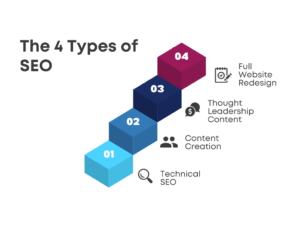
Technical SEO
Technical SEO involves updating the website to ensure it is properly indexed in the search engines and has the ability to rank for a topic. A technical SEO specialist would begin with optimizing site speed, ensuring the site is mobile friendly, updating meta tags and meta descriptions, and indexing the site into the search engines. A complete list of technical SEO factors includes:
- Website Speed: A faster website means a better user experience, which is highly favored by search engines.
- Mobile-Friendly Design: Over 55% of web traffic is mobile users. A website that functions well for them is essential to positive rankings.
- Secure Connection (HTTPS): In the age of web security, search engines heavily favor secure sites.
- Crawlability: It is imperative that search engines can properly crawl and index site content. (Ever seen the robots.txt file? It helps with this.)
- Indexing: The second stage of crawlability. Technical SEO specialists should ensure that search engines have properly crawled and indexed the site.
- Structured Data: Structured data such as schema markup helps search engines understand the content and context of web pages, boosting visibility in search results.
- Error Handling: If there are broken links (404 errors), server errors, or other website errors it will hurt your search rankings.
- URL Structure: Clear and descriptive URLs make it so users and search engines can easily understand what will be on the page. Include keywords where appropriate.
- Canonical Tags: Using canonical tags helps prevent problems caused by duplicate content by specifying the preferred version of a web page.
- Website Architecture and Navigation: Making the website easy to navigate with a dropdown menu structure ensures ease of use for visitors and search engines.
Content Creation
This type of content creation SEO refers to basic content designed to rank either locally or under a broader category. For example, many accounting firms may release articles such as “10 tips for filing your taxes”. In some cases, we see firms posting articles such as “8 of the best restaurants in your city, state”. The reason firms do articles like these is in an attempt to rank locally or a belief that blindly posting content will eventually boost traffic to their website, even if it is not qualified traffic.
In the age of OpenAI’s ChatGPT and Google’s Bard, searchers will no longer be visiting websites to access this type of information. Additionally, searchers visiting a website for this information do not necessarily intend to hire an accounting firm, which decreases conversion rates. More on this later.
Thought Leadership Content
The premise of thought leadership SEO is that, for any accounting firm, there are between 50 and 200 keywords that, if ranked for using proper content that positions the firm as a thought leader, will provide a nearly unlimited amount of leads and sales.
The primary difference between this type of SEO and content creation is we are focusing on concepts that cannot be answered by ChatGPT or Bard because the content is meant to satisfy a buying intent search. For example, someone searching “best accounting firms in Charlotte, NC” is looking for a list of the best accounting firms in Charlotte because they most likely want to hire one. So, you would create a list of the best firms (with your firm ranked at the top, of course) to satisfy that search intent.
This type of SEO also focuses on page design and conversion optimization to ensure an adequate amount of traffic is advancing to the next step of the funnel.
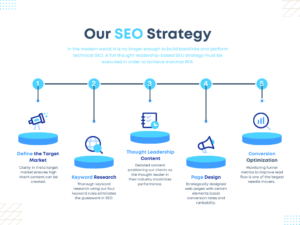
Full Website Redesign
In some cases, larger firms would benefit most from a full website redesign to optimize for conversion and allow the firm to rank highly in a broad number of categories for thought leadership content. While this is an expensive process, for firms with enough volume, the cost quickly vanishes due to the increase in leads that it causes.
It is important to note, if you are pursuing a full website redesign, look into an agency like First Page Sage, which will not only build you a conversion-optimized website but also publish high-quality thought leadership content.
Breakdown of SEO Strategies
Below, we’ve included a table breaking down each SEO strategy into a variety of categories:
- Customization Score: Customization score measures whether the content or strategy could be executed for another firm without much variation. For example, technical SEO is approached the same way for most firms, so the customization score is low. However, a full website redesign is going to be almost entirely custom, giving it a higher score.
- Thought Leadership Score: The majority of ROI potential comes as a direct correlation to the ability of the SEO campaign to present the firm as a thought leader for their niche of accounting. If you specialize in audit, any visitors in your target market should leave with the impression that other accounting firms are not as qualified as you are for audit work.
- Time to Break Even: This is generally how long you can expect to invest in the SEO campaign before you break even, regardless of whether you are using internal resources or outsourcing the campaign.
- Expected Monthly Agency Cost: Because we do not know your internal cost structures, we have simply included the average agency cost for each level of the SEO campaign.
- Recommended Provider: In case you are looking to hire an agency, we have included our recommended provider for each SEO strategy.
| SEO Strategy | Customization Score | Thought Leadership Score | Time to Break Even | Average ROI Potential | Expected Monthly Agency Cost | Recommended Provider |
|---|---|---|---|---|---|---|
| Technical SEO | 3.1 | 3.7 | 6 months | 117% | <$1.5k | MarketingEye |
| Content Creation | 5.4 | 5.1 | 15 months | 160% | $1.5k-$2.5k | Funnel Boost Media |
| Thought Leadership Content | 9.3 | 9.1 | 7 months | 687% | $3k-$7k | Focus Digital |
| Full Website Redesign | 9.7 | 9.5 | 9 months | 748% | >$10k | First Page Sage |
Expected ROI from a Thought Leadership SEO Campaign
In the chart above, you’ll see the estimated ROI and time to break even for each SEO strategy. A few notes on this:
- Estimated ROI is an average of potential ROI over a three-year time horizon. By year three, ROI should be well over 1,000%.
- Time to break even should be measured against ROI potential. While technical SEO has the shortest average break-even time, thought leadership or full website redesign only takes a few more months and yields a much higher ROI.
- These figures are based on a professional agency. If you are executing an SEO strategy for the first time, expect it to take a bit longer to see an ROI as you learn the process.
Keyword Selection and Synergy with Search Intent
There are two factors that move the needle the most with SEO for accounting firms. The first is proper keyword selection, and the second is crafting content that synergizes with the search intent. Working together, these factors unlock a high ROI potential for any firm.
Keyword Selection
Our basic thesis with keyword selection is this: For any company, regardless of industry or size, there are between 50 and 200 keywords that, if ranked, would deliver a near-unlimited amount of leads and sales to the business.
Hub and Spoke Model of Keyword Selection
Typically, we use a hub and spoke model for keyword selection. This type of model is heavily prioritized by Google and other search engines. The hub and spoke model centers around a central concept or idea you are trying to rank for, then creating subpages with more transactional keyword based on that keywords based on that concept. Subpages are created differently based on the intent of the keyword, which is covered further down. A graphical explanation of the hub and spoke is listed below.
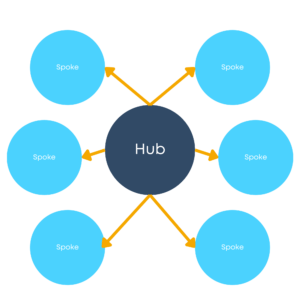
Hubs should include ten or more potential spokes that can be ranked for and have high buying intent. Let’s take a look at an example of an accounting firm focusing on corporate tax planning. As you can see, we have identified a central hub that your firm would like to focus on and then found keywords including the hub keyword that indicate transactional search intent.
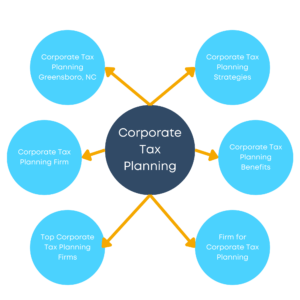
The hub and spoke model works because when a website hosts 10 or more in-depth, thought leadership articles about one particular hub, Google views the site as an authority in that niche, allowing the site to rank higher than competitors with only one or a few pages focusing on that hub.
The Four Keyword Selection Rules
There are four keyword selection rules that must be followed before you build content for that keyword. If these rules are not followed, there could even be negative results for your website. The rules are as follows:
-
- Intent: The keyword would be searched by someone who would realistically be in the market for your services.
- Autofill: The keyword autofills in a dropdown list of 10 when you begin to type it into the search box.
- Competition: If the keyword already has several high-quality results that match the keyword intent well, it may be best to skip the keyword until your site has more credibility in the search algorithm.
- Targeting: If another page on your site is already targeting that page and ranking highly, it is better to update that page instead of creating a brand new page.
Synergy with Search Intent
Once you have selected your keywords, you must design content that synergizes with the search intent. There are 10 different types of pages, and which type you use will depend on the keyword.
- Blog Article: Blog articles are designed to break down concepts or explain a strategy based on the keyword.
- Industry Page: Industry pages highlight your specific work within defined industries and include information relating directly to your clients in that industry.
- Comparison Page: Comparison pages compare different firms or service types. You will commonly see lists on this type of page.
- Product/Service Page: These pages give information about specific services you offer and may include logos of customers, visual breakdowns of your processes, and case studies/testimonials from customers of that service.
- About Page: This should only be one page on your website which gives a synopsis of the firm history and highlights customers you serve.
- Case Study: Case study pages break down individual case studies in greater detail than on a product/service page and explain the methodology that achieved the result.
- Review Page: Review pages center around reviewing products and services available on the market and why they should be considered or not considered.
- White Paper: White papers are research-based pieces that highlight new findings in the market.
- Trend Report: If the market is trending in a certain direction, it may be beneficial to write a report on this. Trend reports could also be used to discuss information like tax trends and how you expect them to affect businesses in the coming years.
- Use Case Page: A use case page shows how a potential customer could benefit from your service using a hyper-specific example.
Best Practices for High-Conversion Content Creation
The end goal for each of your 50-200 thought leadership pages should be a visitor-to-lead conversion rate of at least 2.5% and a ranking of #1 for its keyword. You cannot expect to achieve this result in a competitive market for years, but the good news is as you slowly improve, your lead count will still drastically increase.
There are a few best practices for achieving this result.
Tracking and Attribution
To ensure you are accurately tracking results, we recommend connecting Google Analytics to your site to track the page channels visits are moving through to become a lead. Other tools such as Ahrefs can be used to track the ranking status of your pages on Google and other search engines. An example of a conversion funnel can be seen below:
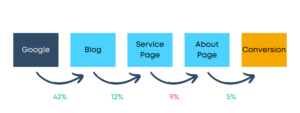
Upon examination of this funnel, we can pinpoint that the service to about page conversion rate is low. This may lead us to split-test the content on the page, the look of the page, and examine content from the previous pages to ensure the content synergizes with the expected result based on the user’s intent.
Anticipation
Reviewing all of your pages to ensure that the content matches what the searcher is anticipating from the keyword and page title is an exercise that should be completed regularly. If the page does not match the intent, then the conversion rate will drop. Changes in the marketplace or recent changes in accounting or tax standards could cause the intent of searches for a specific keyword to shift. Continually re-evaluate your pages to ensure they reflect what the searcher is anticipating from the page.
Scrollability
The reader of the page should be able to grasp the general idea of the page from the headers and bullet points. Lots of people don’t want to read the fine print of the entire article, so if the headers and bullet points tell the story, you’ll pull a larger number of visitors further down your funnel.
Graphical Elements
Graphical elements such as tables, graphs, and diagrams are crucial to optimizing your pages for conversion. If you can summarize the key points of the page in graphical elements, you’ll improve the amount of content your visitors retain from the page. For example, most of our pages begin with a diagram in Google Sheets. From there, we create tables, graphics, and other elements to form the shell of the page. Then, content is filled in around those elements.
Proper Execution of an SEO Campaign
To properly execute an SEO campaign, we recommend the following steps:
- Technical SEO Audit: Firstly, the website should be cleaned up using the technical SEO principles mentioned above. This ensures that your site can properly benefit from the rest of the campaign.
- Keyword Map Creation: From here, we recommend the creation of a keyword map. Essentially, this is a spreadsheet of all of your pages on your site and the keywords they are targeting. This is how you ensure you aren’t targeting the same keyword twice and that all of your pages are updated periodically.
- Keyword Research: Now that you have a keyword map of your current website, research keywords in batches of 10-15 (one hub & spoke at a time) to map the next your of content creation.
- Content Creation: Build content for the researched keywords and note their publication date. Update the content for relevancy at least once per year.
- Conversion Optimization: As traffic increases, watch closely to ensure that each of your pages is converting. If you see a higher or lower conversion rate on a page, take note of what that page is accomplishing that is better/worse than the other website pages and optimize toward or away from that on the rest of your pages.
If you have any questions or want to partner with us to execute an SEO campaign, you can reach out to us on our Contact Us page.